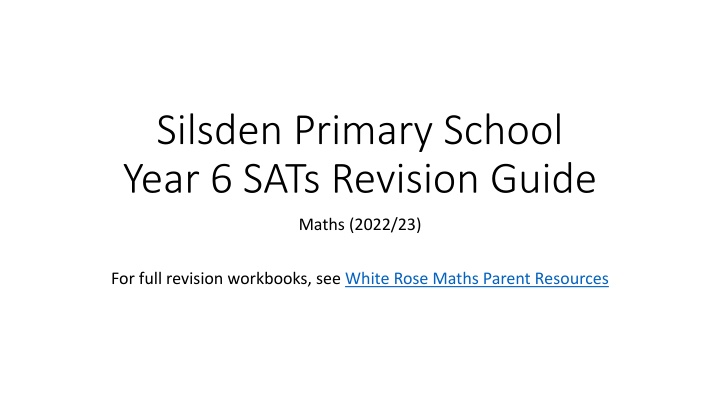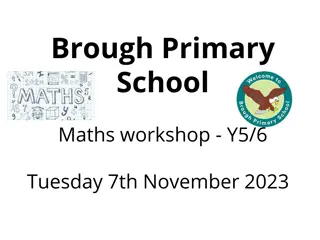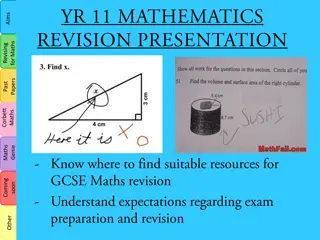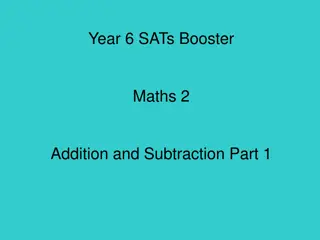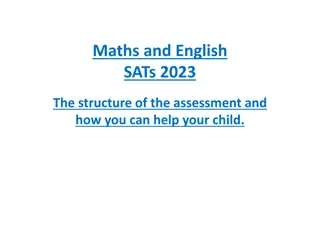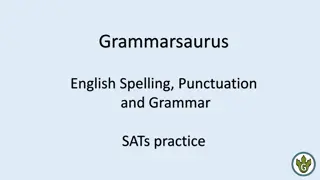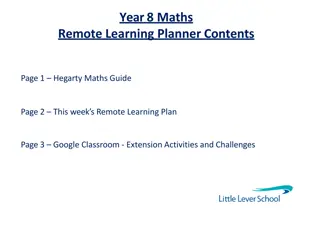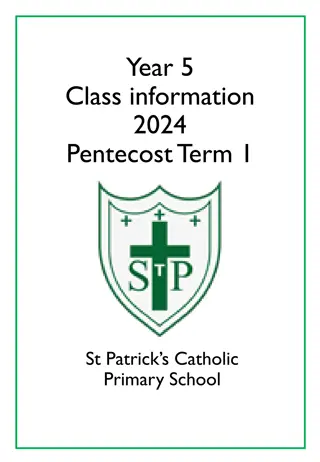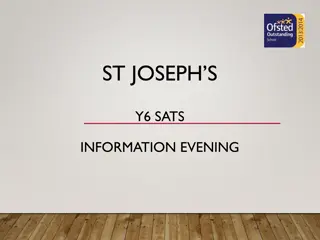Silsden Primary School Year 6 SATs Maths Revision Guide 2022/23
This Year 6 SATs Maths Revision Guide provides comprehensive practice for students, covering topics such as column addition and subtraction, multiplying by multiples of 10, short multiplication, long multiplication, dividing by multiples of 10, short division, and long division. The guide includes detailed explanations and examples to help students prepare effectively for their exams.
Download Presentation

Please find below an Image/Link to download the presentation.
The content on the website is provided AS IS for your information and personal use only. It may not be sold, licensed, or shared on other websites without obtaining consent from the author.If you encounter any issues during the download, it is possible that the publisher has removed the file from their server.
You are allowed to download the files provided on this website for personal or commercial use, subject to the condition that they are used lawfully. All files are the property of their respective owners.
The content on the website is provided AS IS for your information and personal use only. It may not be sold, licensed, or shared on other websites without obtaining consent from the author.
E N D
Presentation Transcript
Silsden Primary School Year 6 SATs Revision Guide Maths (2022/23) For full revision workbooks, see White Rose Maths Parent Resources
Column Addition and Subtraction 3,242 + 17,857 884,091 368,564 13 3 2 4 2 7 8 10 11 + 1 7 8 5 7 8 8 4 9 1 1 - 3 6 8 5 6 4 2 1 0 9 9 5 1 5 5 2 7 Line up the digits using place value knowledge. Leave an exchanging line (2 hundreds + 8 hundreds = 10 hundreds. Exchange 10 hundreds for 1 thousand). Line up the digits using place value knowledge. You cannot swap numbers round. Exchange from column to the left if top digit is less than digit below.
Multiplying by multiples of 10 538 x 10 6.07 x 1000 Digits move 1 place to the left Digits move 3 places to the left Th H T O Th H T O . t h 5 3 8 6 . 0 7 5 3 8 0 6 0 7 0 917 x 100 81.24 x 30 = 81.24 x 10 x 3 Digits move 2 places to the left 8 1 . 2 4 TTh Th H T O (x10) 8 1 2 . 4 9 1 7 x 3 9 1 7 0 0 2 1 2 4 3 7 . 2
Short Multiplication 721 x 6 6 lots of 721 12,408 x 9 9 lots of 12,408 7 2 1 1 2 4 0 8 x 6 x 9 4 1 1 2 3 7 4 3 2 6 1 1 1 6 7 2 Leave an exchanging line
Long Multiplication 3,464 x 47 3,464 x 40 + 3,364 x 7 Side Calculation: 3,464 x 40 = 3,464 x 10 x 4 3 4 6 4 x 4 7 2 3 4 2 2 4 2 4 8 (x7) 3 4 6 4 0 (x10) + 1 3 8 5 6 0 (x40) x 4 1 1 1 2 1 1 6 2 8 0 8 1 3 8 5 6 0
Dividing by multiples of 10 650 10 1,206 1000 Digits move 1 place to the right Digits move 3 places to the right H T O Th H T O . t h Th 6 5 0 1 2 0 6 6 5 1 . 2 0 6 39,400 100 760 40 = 760 10 4 Digits move 2 places to the right H T O 7 6 0 TTh Th H T O 7 6 ( 10) 3 9 4 0 0 3 9 4 76 4 = 19
Short Division 432 8 5,420 7 0 5 0 4 5 4 7 7 4 r2 43 32 54 52 30 8 7
Long Division 4,392 72 Start with known facts 1 x 72 = 72 2 x 72 = 144 (double) 10 x 72 = 720 (digits 1 place left) 5 x 72 = 360 (half of 10 x) 20 x 72 = 1,440 (10 x 2 x 72) 50 x 72 = 3,600 (10 x 5 x 72) 6 9 0 9 2 7 7 1 2 0 2 0 2 2 0 34 3 13 6 7 7 72 - (50x) - (10x) - (1x)
Working with decimals add and subtract 56.09 + 1.735 Line up digits using place value knowledge. Use decimal point to help (must line up). Do not forget decimal point in answer line! 7 3.54 Estimate first: 7 3 = 4 so answer will be less than 4 (as taking away more than 3). 6 9 10 10 7 . 5 6 . 0 9 0 - 3 . 5 4 + 1 . 7 1 8 3 5 3 . 4 6 5 7 . 2 5
Working with decimals multiply and divide 14.57 x 5 5 lots of 14.57 5 underneath the furthest right column. 78.75 5 1 7 5 . . 7 5 28 37 25 5 1 4 . 5 7 x 5 2 2 3 7 2 . 8 5
Factors and Prime Numbers Factors of 18: 1 and 18 2 and 9 3 and 6 Factors of 25: 1 and 25 5 18 and 25 do not share a common factor (other than 1). Prime factors are factors that are also prime numbers. A prime number has exactly two factors 1 and itself. 2 is the only even prime number. 1 is not a prime number as it has only 1 factor. (1 x 18 = 18) (2 x 9 = 18) (3 x 6 = 18) (1 x 25 = 25) (5 x 5 = 25) Prime numbers up to 20: 2, 3, 5, 7, 11, 13, 17, 19 Prime factors of 24 in red: Factor pairs: 1 and 24 3 and 8 2 and 12 4 and 6
Common Multiples A multiple of a number is any number that appears in its times table. Multiples of 4: 4, 8, 12, 16, 20, 24, 28, 32, 36, 40, 44, 48, 52, 56 etc. Multiples of 7: 7, 14, 21, 28, 35, 42, 49, 56, 63, 70, 77, 84, 91, 98 etc. A common multiple is a multiple that is shared by two or more numbers. E.g. the first two common multiples of 4 and 7 are 28 and 56. The lowest common multiple of 4 and 7 is 28.
Square and Cube Numbers A square number is the product (result) of multiplying a number by itself. A cube number is the product (result) of multiplying a number by itself and itself again. 32= 3 x 3 = 9 82= 8 x 8 = 64 102= 10 x 10 = 100 53= 5 x 5 x 5 = 125 63= 6 x 6 x 6 = 216 93= 9 x 9 x 9 = 729
BIDMAS (order of operations) Brackets Indices (squares and cubes) Division Multiplication Addition Subtraction 92 36 9 = indices, then division, then subtraction = 81 36 9 = 81 4 = 77
Fractions - language 5 8 Numerator (how many parts you have) Denominator (how many parts make up the whole)
Improper Fractions and Mixed Numbers Improper fractions have a numerator higher than the denominator. Mixed numbers are made up of an integer (whole number) and a fraction. 3 17 5 2 5 =
Fractions with the same denominator 8/10 3/10 = 5/10 3/9 + 4/9 = 7/9 Simplifies to 1/2 x x x
Fractions with the different denominator In order to add, subtract, compare or order fractions, you must have a COMMON DENOMINATOR 4/7 + 5/6 Step 1: Find equivalent fractions using a common denominator 4/7 = 24/42 (multiply both numerator and denominator by 6) 5/6 = 35/42 (multiply both numerator and denominator by 7) 24/42 + 35/42 = 59/42 Convert to mixed number: 59/42 = 1 17/42
Multiplying Fractions 3/13 x 4 ( 4 lots of 3/13 ) = 12/13 Top tip: Multiply the numerator only by the integer. E.g. 7/12 x 3 = 21/12 Multiply fractions by fractions: Multiply numerator and denominator E.g. 1/4 x 1/2 = 1/8 2/3 x 1/7 = 2/21 = 1 9/12
Dividing Fractions 3/4 5 3/4 divided into 5 equal parts So you have something less than a whole (3/4) and you are dividing that into even smaller parts. 3/4 5 = 3/20 Top tip: Multiply the denominator only by the divisor. E.g. 4/9 3 = 4/27 E.g. 2/17 4 = 2/68 = simplifies to 1/34
Percentages Per cent means out of 100 73/100 = 73 out of 100 = 73% 16/25 = 64/100 (equivalent fraction) = 64% Finding a percentage of an amount Find 10% by dividing the amount by 10 Find 1% by dividing the amount by 100 Use known facts to find any percentage 37% of 180 --> (10% of 70 = 7) (1% of 365 = 3.65) (37% = 30% + 7%) 10% = 18 so 30% = 18 x 3 = 54 1% = 1.8 so 7% = 1.8 x 7 = 12.6 = 54 + 12.6 = 66.6
Fraction-Decimal-Percentage Equivalence Fraction 1/2 1/4 3/4 1/5 2/5 Decimal 0.5 0.25 0.75 0.2 0.4 Percentage 50% 25% 75% 20% 40%
Algebra a + b = 16 What is b if a = 7? Substitute in the value of a: 7 + b = 16 So b must = 9 13 + 4h = 25 What is h? 13 + (4 x h) = 25 4 x h = 12 h = 3
Ratio and Scale There are 6 lemons for every 2 limes. There is a ratio of 6 lemons to 2 limes, expressed as 6:2 How many lemons would there be if there were 8 limes? 6:2 = 12:4 = 18:6 = 24:8 There would be 24 lemons A model car is built using a scale of 1:10 If the length of the model car is 30 cm, how long is the actual car? Scale of 1:10 = 30:300 The actual car is 300cm long (=3m)
Perimeter The distance around the outside of a shape. Perimeter of a rectangle Perimeter = 2 (8 + 6) = 2 x 14 = 28cm = 2 (length + width) = 2 (L + W) 8cm 6cm
Area The space covered by a 2-dimensional (2D) shape Area is measure in square units (mm2, cm2, m2) Area of a rectangle = length x width (L x W) Area = 5 x 3 = 15cm2 5cm 3cm Area of a triangle = base x perpendicular height Area of a parallelogram = base x height 6m = 24 2 = 12m2 2 4m = 14mm2 2mm 7mm
Volume The space taken up by a 3-dimensional (3D) shape Volume is measure in cube units (mm3, cm3, m3) Volume of a cuboid = length x width x height = L x W x H = 12 x 5 x 7 = 60 x 7 = 420cm3 7cm 5cm 12cm
Converting Units of Measurement (length) 10 mm = 1 cm 100 cm = 1 m 1,000 m = 1 km 5 miles = 8 kilometres (approx.) (5:8 ratio) Using this 2.5 miles = 4 km 20 miles = 40 km 800 km = 500 miles 3,600m = 3.6km ( 1,000) 5.6cm = 56mm (x 10) Other imperial units: inches, feet, yards
Converting Units of Measurement (mass and capacity) Mass 1,000g = 1 kg 1,000kg = 1 (metric) tonne Capacity 1,000ml = 1 litre 3.75 l = 3,750 ml (x 1,000) 6,350 ml = 6.35 l ( 1,000) 7kg = 7,000g (x 1,000) 2,300 kg = 2.3 tonnes ( 1,000) Other imperial measures: pints, gallons Other imperial measures: ounces, pounds, stones
Time 60 seconds in a minute 60 minutes in an hour 24 hours in a day 7 days in a week 52 weeks (approx.) in a year 365 days in a year 366 days in a leap year (every 4 years) Thirty days has September, April, June, and November, All the rest have thirty-one, Save February at twenty-eight, But leap year, coming once in four, February then has one day more. Do not use a column method to add and subtract time (not base 10!)
Money 100 pence in 1 Money should always be expressed with 2 decimal places. 1.50 not 1.5 Tina buys a cake for 4.59 and a tub of ice cream for 2.99. How much change does she get from 10? Step 1: 4.59 + 2.99 = 7.58 9 9 10 10 10 1 . - 7 . 5 8 2 . 4 2
Angles An angle is the amount of turn between two straight lines that meet at a common point. Angles are measured in degrees (o), using a protractor. Acute angles --> below 90o Right angle --> exactly 90o (1/4 turn) Obtuse angle --> above 90o and below 180o Straight line --> exactly 180o (1/2 turn) Reflex angle --> above 180o and below 360o (270o = 3/4 turn) Circle --> 360o (full turn)
Properties of Shape (2-dimensional) A polygon is a 2-dimensional (2D) closed shape with 3 or more straight sides. Regular = all sides and angles are equal. Irregular = not all the sides and angles are equal. Quadrilateral = a polygon with 4-straight sides parallelogram trapezium isosceles triangle (2-sides and angles equal) equilateral triangle (all sides and angles equal) pentagon right-angled triangle hexagon octagon
Properties of Shape (3-dimensional) 3-dimensional (3D) shapes have faces, edges and vertices. edge face A cuboid has 6 faces, 12 edges and 8 vertices vertex (plural = vertices) A net is a 2D representation of a 3D shape. cube cuboid cylinder cube (triangular) prism (equal faces) (equal faces)
Geometry Position and Direction The position of a shape can be described using co-ordinates (x,y). The x co-ordinate always comes first. y A (3,1) x A translation is a movement of a shape without flipping or rotating it. e.g. A ---> B (5 right, 2 down) A B A shape can also be reflected in a mirror line. e.g. J ---> K (reflected in mirror line) K J
